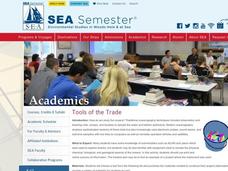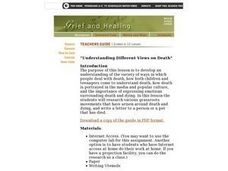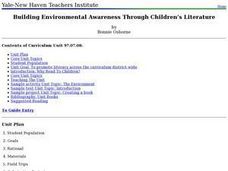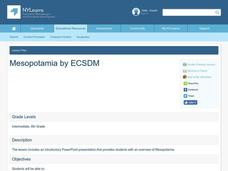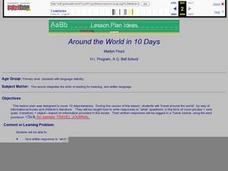Curated OER
Irregular and plural -ar verbs
Students prepare for a Spanish quiz by practicing irregular and plural -ar verbs. This lesson offers excellent resource links and practice quizzes (found at www.quia.com) to enhance student success.
Curated OER
Wizards and Resumes
Students research the work of J.K. Rowling and use it to make her resume. They view websites to get a clear idea of what resumes should look like and create their own career portfolio.
Curated OER
Tools of the Trade
Students construct functional replicas of oceanographic tools and demonstrate and explain their use.
Curated OER
The Visible Spectroscopy Expert Witness Problem
In a simulated crime science investigation, chemistry or physics sleuths use spectroscopy to analyze solutions. The lesson gives learners practice making salicylate solutions, using spectrophotometers, calculating dilution amounts,...
Curated OER
Gold Rush California and its Diverse Population
Students compare contemporary cultural differences with historical differences based on population percentage. In this cross-curriculum Gold Rush/math lesson plan, students analyze aspects of California's Gold Rush population and...
PACER Center
Notifying the School About a Bullying Incident—Using a Template Letter
A pre-made letter is ideal for parents to use if their child is being bullied. The template comes with a brief overview for implementation, as well as two separate 504 and IEP templates to address bullying instances. Use the document...
Curated OER
Understanding Different Views on Death
A thought-provoking lesson presents how different cultures view death. Upper elementary through high school pupils engage in a series of activities that will leave them with a new understanding of how death is dealt with globally....
Noyce Foundation
Ducklings
The class gets their mean and median all in a row with an assessment task that uses a population of ducklings to work with data displays and measures of central tendency. Pupils create a frequency chart and calculate the mean and median....
Curated OER
The Great State!
The creation of state home pages is the focus of this lesson. Learners research one of15 states for which special State Quarters have been released, and create a home page for that state. They also perform Internet research and utilize...
Cornell University
Plant Cell Crime Scene
Use science to solve the mystery of the Poplar murder. Pupils use forensic botany to determine if a suspect could be the killer. By analyzing images from a Transmission Electron Microscope, learners determine if the material found on the...
Curated OER
Environmental Awareness and Children's Literature
Use an alternative setting for pregnant teens and young mothers, as well as special education children to examine environmental topics through literature. Included in this unit is a visit to neighborhood libraries to select children's...
Curated OER
Mesopotamia
Sixth graders describe the geography of Mesopotamia, explain the characteristics of Sumerian city-states, and identify the cultural practices of the ancient Sumerians. They then explain how empires formed in Mesopotamia.
Curated OER
Graphic Organizer: Research Note Taking Made Easy
What do you wonder about bats? Use an open-ended question like this to engage your class and interest them in an upcoming research project. There's a list of example questions to offer or suggest regarding bats, but see what they can...
Missouri Department of Elementary
The Successful Student: Just Checking
The final lesson in a skill-based series focuses on setting goals and making checklists. Class members discuss what it means to set realistic goals and practice making lists to manage their time effectively.
Curated OER
Flower Dissection
In this science worksheet, students follow directions for dissecting a flower. Kids tape the parts of the flower in the corresponding boxes. Students also read about how flowers reproduce and analyze a related diagram.
Pearson
Langston Hughes
An author study provides learners the opportunity to explore in depth the life of, the influences on, and the works of a single literary figure. Introduce middle schoolers to Langston Hughes with a unit that models how to approach an...
Curated OER
Creating Children's Books
Students collaborate to create a children's book. In this visual arts lesson, student study the components and procedures that go into making a children's book including the shape, size. layout, biographical information about the author,...
Curated OER
SPEECHES TO INTRODUCE
Pupils create multimedia speeches of introduction which focus on women and Hispanics. They introduce their famous person and, using a video camera, video tape their speeches.
Curated OER
Telling Time Lesson Plan
Judy Clocks are a great invention. Here, learners review telling time to hour and half hour on Judy clocks, begin telling time to quarter hour, use clock stamps to practice, and play computer games using Trudy's Time and Place House...
TPS Journal
Sourcing a Document: The First Thanksgiving
How reliable is a painting of the first Thanksgiving if it was created 300 years after the fact? Learners assess the validity of a primary source image to determine what it can actually reveal about this event.
Curated OER
Ocean Life
Mini-marine biologists use Scholastic Explorers website to learn about declining numbers of leatherback sea turtles and dusky dolphins. They fill out a K-W-L chart and observation journal worksheet, which are both provided in the lesson...
Curated OER
Around the World in 10 Days
Students engage in producing responses to "what" questions and their written responses will be recorded in a Travel Journal. They produce their respones using a word processor. This activity is very detailed and a rubic is included.
Curated OER
Exploring US Foreign Policy after WWII--The Cold War
Scholars explore U.S. Foreign Policy and Cold War ideologies adopted after WWII. They conduct Internet research on a topic or issue related to the Cold War Era, watch two films, and compose a time line and a multimedia presentation to...
Curated OER
Carbon 14 Dating in Practice II
Your archaeologists combine proportional reasoning with exponential functions in a real-life task centered on Carbon 14 dating.




